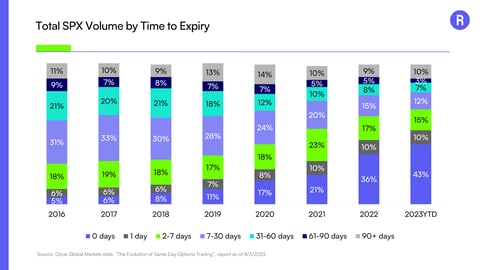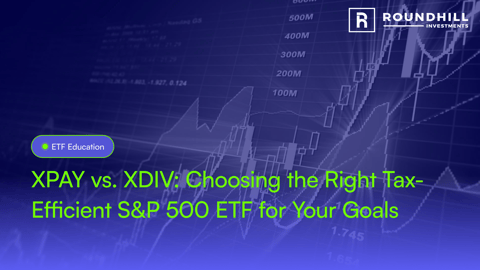Did I Miss the Trade? Opportunities in AI
ChatGPT was released more than two years ago, but the AI trade is not yet showing any signs of slowing down. The Roundhill Generative AI & Technology ETF (CHAT) recently hit all-time price highs while outperforming the S&P 500 by almost 20% since September 6.
Source: Bloomberg; Data as of January 9, 2025. "Normalized" refers to adjusting data to a common scale or baseline, which allows for easier comparison between different datasets, even if they have different units, magnitudes, or starting points. The performance data quoted represents past performance. Past performance does not guarantee future results. Current performance may be lower or higher than the performance data quoted. The investment return and principal value of an investment will fluctuate so that an investor's shares, when sold or redeemed, may be worth more or less than their original cost. Returns less than one year are not annualized. For the most recent month-end performance, please call (855) 561-5728. For more information, including current holdings and standardized performance: https://www.roundhillinvestments.com/etf/chat/
Let’s dig into CHAT’s holdings and present five generative AI stocks that appear to offer compelling long-term set-ups.
Marvel Technology - MRVL
From the end of January 2023 to December 2024, Marvel Technology appreciated 274% in price. At the surface level, that data point alone could lead most investors to consider the trade to be over. However, MRVL was rallying off major support in January 2023, the previous all-time high from January 2006. MRVL subsequently moved from ~$36.80 to over $100 in December of 2024, breaking out to record all-time highs. From a technical perspective, MRVL appears to be in the early innings of a major move higher.
Source: Bloomberg; Data as of January 9, 2025. Past performance does not guarantee future results.
Salesforce - CRM
From our vantage point, the long-term chart of Salesforce (CRM) is a textbook uptrend. In its roughly 20-year trading history, CRM has generally risen in price since its IPO. That being said, CRM did peak in late-2021 as Technology companies struggled to perform in 2022’s bear market. After bottoming in December 2022, CRM accelerated in price and ultimately broke out to new all-time highs in November 2024. The stock has been testing support at ~320 after breaking out of a 3-year consolidation in price. CRM’s next leg higher could just be getting started.
Source: Bloomberg; Data as of January 9, 2025. Past performance does not guarantee future results.
SK Hynix - 000660 KS
SK Hynix (000660 KS) is a semiconductor company based in South Korea. While SK Hynix is only down roughly 13% from its June 2024 high, it is down over 71% from its record all-time high set in August 1999. The stock is currently in a small consolidation in what has been a two decade rise in share price. In our view, the path of least resistance appears higher for SK Hynix. A close above the monthly high established in June of last year would be a resumption of the uptrend.
Source: Bloomberg; Data as of January 9, 2025. Past performance does not guarantee future results.
Micron Technology - MU
Until March 2024, Micron (MU) had not seen all-time highs in over twenty years. MU has roundtripped from its July 2000 peak, previously traded under $2 a share in 2008, and is now trading near $100. In our view, the current consolidation is a healthy test of what could be a structural breakout in MU.
Source: Bloomberg; Data as of January 9, 2025. Past performance does not guarantee future results.
Inventec - 2356 TT
Taiwan based, technology hardware producer Inventec (2356 TT) has been consolidating in a coiling range since its surge to an intra-month all-time high in July 2023. After hitting a 73.50 TWD share price, Inventec reversed almost 50% and has subsequently been making lower highs and higher lows. Why does this matter? This pick-up in volatility and coiling range is occurring after a 24-year base breakout. From a long-term view, Inventec is consolidating a massive surge higher in price, albeit with pronounced volatility.
Source: Bloomberg; Data as of January 9, 2025. Past performance does not guarantee future results.
Why CHAT?
The Roundhill Generative AI & Technology ETF (CHAT) kicked off 2025 by rallying to all-time highs on January 6. In the context of a strong uptrend, the fund has outperformed the broader S&P 500 since early September. There are several generative AI stocks that may seem overextended in the short term, but could signal the early stages of significant structural growth when viewed from a broader, long-term perspective—beyond the noise of daily market fluctuations.
In our view, there are domestic and global AI investment opportunities that remain in their nascent stages. With CHAT, investors can position themselves to capture these opportunities in the generative AI sector.
Learn more about CHAT.
Investors should consider the investment objectives, risk, charges and expenses carefully before investing. For a prospectus or summary prospectus with this and other information about Roundhill ETFs please call 1-855-561-5728 or visit the website at www.roundhillinvestments.com/etf/. Read the prospectus or summary prospectus carefully before investing.
Artificial Intelligence Company Risk. Companies involved in, or exposed to, artificial intelligence related businesses may have limited product lines, markets, financial resources or personnel. These companies face intense competition and potentially rapid product obsolescence, and many depend significantly on retaining and growing the consumer base of their respective products and services.
Technology Sector Risk. The Fund will invest substantially in companies in the information technology sector, and therefore the performance of the Fund could be negatively impacted by events affecting this sector. Market or economic factors impacting technology companies and companies that rely heavily on technological advances could have a significant effect on the value of the Fund’s investments. The value of stocks of information technology companies and companies that rely heavily on technology is particularly vulnerable to rapid changes in technology product cycles, rapid product obsolescence, government regulation and competition, both domestically and internationally, including competition from foreign competitors with lower production costs.
New Fund Risk. The Fund is a recently organized management investment company with no operating history. As a result, prospective investors do not have a track record or history on which to base their investment decisions. Small-Capitalization Investing. The securities of small-capitalization companies may be more vulnerable to adverse issuer, market, political, or economic developments than securities of large- or mid-capitalization companies. The securities of small capitalization companies generally trade in lower volumes and are subject to greater and more unpredictable price changes than large- or mid-capitalization stocks or the stock market as a whole.
Micro-Capitalization Investing. Micro-capitalization companies often have limited product lines, narrower markets for their goods and/or services and more limited managerial and financial resources than larger, more established companies, including companies which are considered small- or mid-capitalization.
Concentration Risk. The Fund will be concentrated in securities of issuers having their principal business activities in the technology group of industries. To the extent that the Fund concentrates in a group of industries, it will be subject to the risk that economic, political, or other conditions that have a negative effect on that group of industries will negatively impact them to a greater extent than if its assets were invested in a wider variety of industries.
CHAT is distributed by Foreside Fund Services, LLC.
Glossary:
S&P 500: The S&P 500® is widely regarded as the best single gauge of large-cap U.S. equities and serves as the foundation for a wide range of investment products. The index includes 500 leading companies and captures approximately 80% coverage of available market capitalization.
Breakout: A breakout is when the price of an asset moves above a resistance area, or moves below a support area. Breakouts indicate the potential for the price to start trending in the breakout direction. For example, a breakout to the upside from a chart pattern could indicate the price will start trending higher.
Breakdown: A breakdown is a downward move in a security's price, usually through an identified level of support, that portends further declines. A breakdown commonly occurs on heavy volume and the subsequent move lower tends to be quick in duration and severe in magnitude.
Resistance: Resistance is one of the foundational elements of technical analysis (along with its corollary: support). Resistance is a price or price zone above the current market that contains the upside movement of an asset. Resistance is where selling interest appears over time, blocking further upside progress.
Support: A support level is the price level that an asset doesn't fall below for a period of time. An asset's support level is created by buyers entering the market whenever the asset dips to a lower price.
Relative Performance (Return): Relative performance is the return an asset achieves over a period of time compared to a benchmark. The relative return is the difference between the asset’s return and the return of the benchmark.
Uptrend: An uptrend describes the price movement of a financial asset when the overall direction is upward. In an uptrend, each successive peak and trough is higher than the ones found earlier in the trend. The uptrend is therefore composed of higher swing lows and higher swing highs. As long as the price is making these higher swing lows and higher swing highs, the uptrend is considered intact.
Downtrend: A downtrend is a gradual reduction in the price or value of a stock or commodity, or the activity of a financial market. A downtrend can be contrasted with an uptrend.




